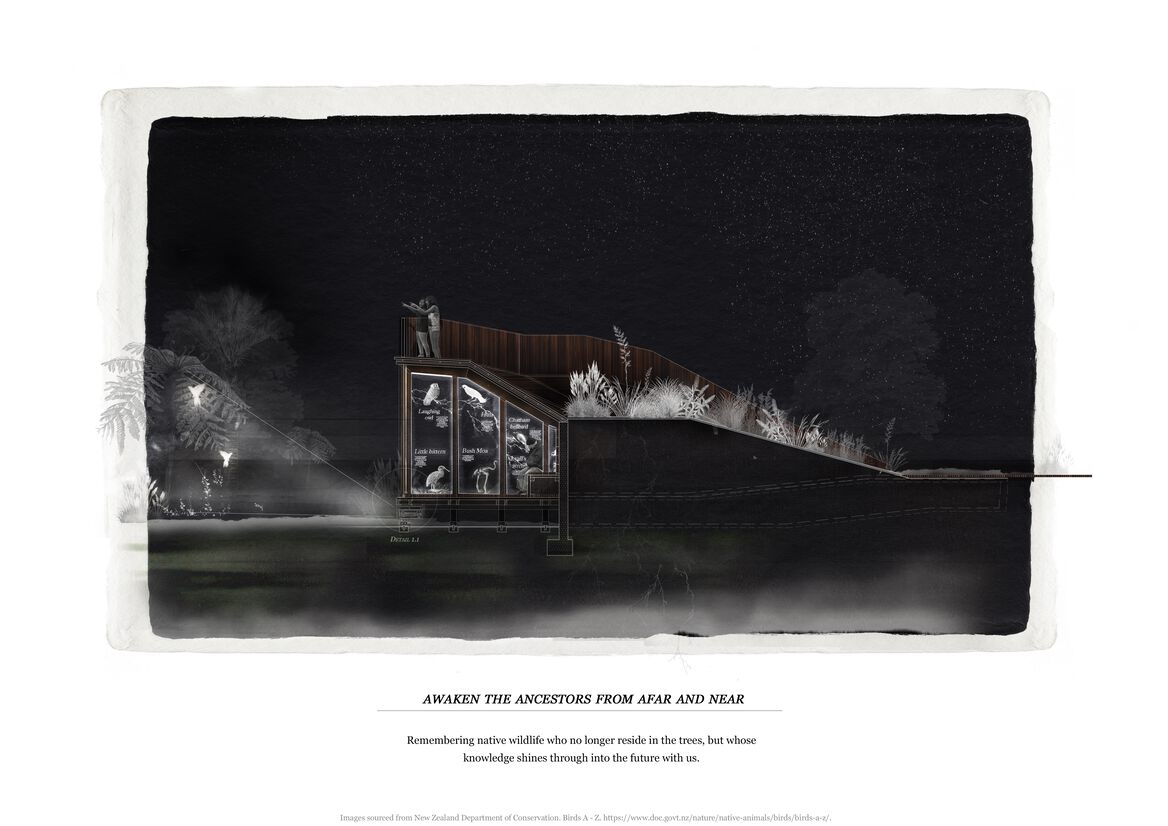Spatial
Madison Lynskey-Reid Shadows of the Land
-
Tauira / Student
Madison Lynskey-Reid -
Kaiako / Lecturers
Georgina Stokes – Ngāi Tahu, Jen Archer-Martin – Ngāpuhi










Description:
When rangatira Nōpera Pana-kareao signed the 1840 Treaty of Waitangi at Kaitāia, he proclaimed that ‘the shadow of the land will go to [the Governor] but the substance will remain with us’. Only a year later, Nōpera’s optimism turned to fear that the substance of the land would go to the British; only the shadow would remain for Māori (Angela Ballara, ‘Pana-kareao, Nōpera’, teara.govt.nz).
This speculative project re-imagines the south lawn and visitors centre of Government House, proposing an encounter with mātauranga Māori, called forth from the living shadows of the land to stand in true partnership. It joins the many voices reasserting the value of mātauranga Māori, marginalised by colonisation, as essential to the expression of rangatiratanga and exercising of kaitiakitanga. Shadows of the Land reflects Aotearoa’s unique collective identity, responding to changing public desire toward care for the environment and the rights of tangata whenua to uphold the mana and mauri of ancestral landscapes.
As a Pākehā student, I acknowledge the privilege of this opportunity to work toward a better understanding of my roles and responsibilities as Tangata Tiriti. In the context of the undergraduate studio, I did not have access to working in the kind of Te Tiriti-led co-design partnership with mana whenua that this kaupapa necessitates. In lieu of partnership, interrogation of my own identity and positionality was woven into the research. I relied on the published wisdom of kaumatua and tohunga, most notably tohunga rongoā Tohe Ashby, whose words drive the project. The proposed design is thus conceived as a vessel for the voices of others, with visualised content merely placeholders for that which would be co-created. At its core, the project seeks to serve the generations of kaitiaki who care for this land.
Shadows of the Land is situated within the environment and ecologies around Government House, a site rich with life and cultural value. Physically, it was once a place of food gathering and cultivation. Spiritually, it is still imbued with the wairua and mauri of the flora and fauna that surround it. Attunement to the cycles and rhythms of place is connected with the moon and stars – with night time and darkness. The proposed experience is therefore programmed to occur at night, in a series of pavilions set on the south lawn of Government House. Visitors are invited to take a journey through the shared philosophical, spiritual and ecological knowledge of the land. Guided by mana whenua, the experience highlights the relationship between rhythms of the whenua, wildlife, plants, and surges, governed by the moon, and the management of natural resources within the region.
When the sun sets, life awakens in the shadows of the land. Through listening to the knowledge in the shadows and embracing a transformational understanding of the past, we will be guided toward a brighter future – for the land and all its people.
Judge's comments:
This project is a sensitive and well considered exploration into the role of architecture in decolonising Aotearoa. The resulting pavilion celebrates many aspects of te ao Māori and sits comfortably in the loaded political landscape of Government House. The designer shows appropriate understanding and respect for the role of co-design and partnership with Mana Whenua in a project such as this.
Showing respect and understanding for the importance of co-design the resulting pavilion celebrates many aspects of Te Ao Māori sitting within the charged political landscape of Old Government House.